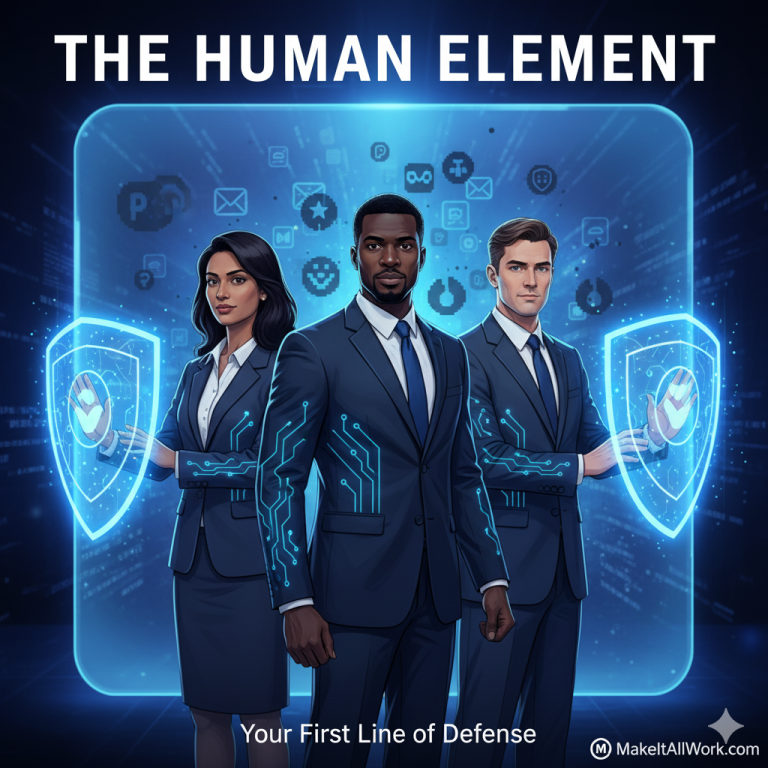Beyond Firewalls: Turning Your Team into Your First Line of Defense

We often talk about sophisticated firewalls, complex encryption, and advanced threat detection when discussing cybersecurity. But here at MakeItAllWork.com, we know the truth: the most critical, and often weakest, link in your security chain isn’t a server—it’s a human.
That’s right, your dedicated employees, the people who power your business, can also be your biggest cybersecurity vulnerability. Phishing emails, weak passwords, and simple human error account for a huge percentage of successful data breaches.
But don’t panic! This isn’t a problem without a solution. The angle we want to take is simple: We need to turn your employees from a liability into your proactive first line of defense.
Let’s dive into the human element of cybersecurity and how a cultural shift, not just a software update, can secure your future.
My employees are smart and dedicated. Why are they my “biggest vulnerability”?
A: It’s not about intelligence or intent; it’s about being human and being targeted. Cybercriminals know it’s often easier to trick a person than to hack a well-configured system. They prey on our innate human behaviors:
- Curiosity: “Oh, a package notification I didn’t expect? I’ll click that!”
- Urgency/Fear: “A stern email from ‘HR’ saying my account will be locked? I better enter my password immediately!”
- Distraction: Trying to multitask while working quickly, leading to missed red flags in an email.
Simply put, a hacker only needs to find one tired, busy, or stressed employee to click one link, and they’re in. That single click bypasses all your expensive technical controls.
If human error is inevitable, what can I actually do about it?
A: You can’t eliminate human error, but you can dramatically reduce the risk through security awareness and training. Think of your team not as passive users, but as active security sensors.
The shift is from a reactive, punitive mindset (“Don’t mess up!”) to a proactive, collaborative culture (“Here’s how we protect each other and the company”). Your goal is to make identifying a threat second nature, just like buckling a seatbelt.
What makes for effective security training? Isn’t an annual PowerPoint deck enough?
A: Absolutely not. The “annual mandatory compliance video” is usually forgotten by lunchtime. Effective training needs to be:
- Frequent and Ongoing: Threats evolve constantly. Training should be continuous—monthly, quarterly, or delivered in micro-lessons throughout the year.
- Relevant and Real-World: Use examples based on phishing attempts currently targeting your industry or even your company specifically.
- Interactive and Engaging: Gamified modules, scenario-based learning, and short, focused videos are much more effective than dry presentations.
- Tested (with Phishing Simulations): The best way to gauge preparedness is through controlled, realistic phishing simulations. Those who fail get immediate, supportive re-training, not a reprimand.
The takeaway: Security training shouldn’t feel like a chore; it should feel like empowering your team with critical skills.
Besides training, what cultural steps can turn my team into a defensive force?
A: This is where the magic happens—it’s all about creating a culture of security.
- Foster a “Speak Up” Environment: Employees must feel comfortable reporting something suspicious without fear of being blamed or punished. If an employee clicks a bad link, the immediate goal should be isolating the threat, not penalizing the person. Make reporting simple and non-judgmental.
- Lead by Example: If company leadership uses weak passwords or ignores security protocols, the rest of the team will too. Security starts at the top.
- Simplify Security Processes: If your security policy is too complicated, people will find workarounds. Make it easy to do the secure thing: implement a user-friendly password manager and make Multi-Factor Authentication (MFA) a one-click process.
- Recognize and Reward: Acknowledge and celebrate employees who successfully spot and report a phishing attempt. Positive reinforcement works far better than negative.
How does this “human element” approach integrate with our technical cybersecurity?
A: The human element and technical controls are two sides of the same security coin. They must work together:
- Technology as the Net: Tools like email filters catch the vast majority of junk and known phishing attempts before they reach the employee’s inbox.
- The Employee as the Final Firewall: Your well-trained team is the final layer that catches the highly sophisticated, customized phishing attacks that slip past the filters.
- Policy Enforcement: Tools can enforce the policies your training advocates (e.g., requiring MFA, blocking unauthorized software installs, or limiting access based on the Zero Trust principles we’ve discussed before).
By investing in both, you create a robust, multi-layered defense where technology handles the volume and your team handles the precision.
Ready to Empower Your First Line of Defense?
Your employees are your greatest asset, and when properly trained and supported, they become your most effective security defense. Shifting from a blame-and-punish model to an empower-and-protect culture is the smart, sustainable way to build long-term cyber resilience.
At MakeItAllWork.com, we specialize in building these secure cultures, from custom-designed security awareness training programs to implementing the technical controls that support your team.
Ready to stop viewing your employees as a risk and start leveraging them as your first line of defense? Contact MakeItAllWork today for a personalized assessment of your human firewall and training needs!

 ALL BLOGS
ALL BLOGS


